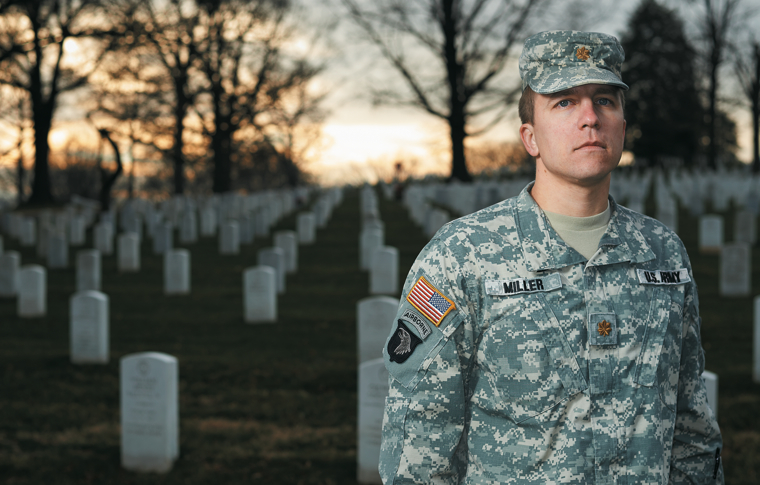At Arlington National Cemetery, 'The Old Guard' Embraces New Technology
In a unique application of mobile technology, Arlington National Cemetery issued 60 Apple iPhones to more than 70 soldiers who spent three months photographing and mapping the cemetery’s entire 624 acres. Arlington made news in October 2012 when it launched the ANC Explorer app, which allows visitors to find the graves of loved ones using Apple iOS or Google Android smartphones, as well as the cemetery’s website or kiosks located at Arlington. Hard work over the preceding 18 months made the app possible.
“We had a huge data collection initiative to digitize the cemetery,” Army Major Nicholas Miller, CIO of the cemetery, says. “It included collecting markers, scanning burial records, and combining them with accurate GPS coordinates and photos.”
The project is one of numerous innovative uses that government organizations — including the Veterans Affairs Department and the Nuclear Regulatory Commission — are finding for mobile technologies.
Tablets and smartphones are greatly expanding the reach of computing power, and the uses that agencies are finding for them appear to be limited only by the imagination.
Mapping Hallowed Ground
Using an Army-developed iPhone app, soldiers from the Army’s 3rd Infantry Regiment, known as “The Old Guard,” photographed the front and back of every headstone and urn niche at Arlington, then transported the data back to a Defense Department server. Data was coupled with contractor-scanned Army records and packaged into a single record per site, each validated as part of Arlington’s 100 percent accountability review.
Specialized handhelds were used to collect geospatial information added to each record. Thanks to an Army flyover of the cemetery, the mapping is accurate to within 3 inches, Arlington National public affairs officer Jennifer Lynch says.
The resulting database became the basis for a new Arlington National Cemetery geospatial information system (GIS) that helps cemetery leadership to manage the cemetery and maintain accountability for the veterans buried there as well as provide information for the visitor app.
Army-issued iPhones were not connected to the Army network and were used only to collect publicly available information, so the devices themselves didn’t require additional security. “What we worried about was the information that hit our servers,” Miller says. In the field, users are authenticated by the iPhone app. “As the information comes into an Army information system, it’s scanned and validated based on the device, the user, and other security protocols, before it’s unpacked and loaded into the database.”
Arlington has integrated the app into its day-to-day processes and continues to add information to its database. “We keep finding new uses for mobile and GIS technology,” Miller says. “They enhance our knowledge of our own business, as well as the accountability of our processes.”
Taking Help to the Homeless
The number of tablets that the federal government needs by the end of 2013 to keep pace with tablet adoption.
SOURCE: “Mobile Powered Government” (MeriTalk 2012)
At the Veterans Affairs Department, another pilot faces a greater security challenge. VA recently deployed about 40 tablets to social workers throughout the country whose job it is to identify homeless veterans and get them the help they need. For years, the paper-based process faced serious challenges. Case workers would find individuals in the field, take notes, then return to their offices to enter the information into computers and conduct research. But there was a chance they could lose touch with the veterans.
“The rate at which they initially found homeless veterans was high, so VA is leveraging technology to improve the rate of engagement and reduce the potential for a veteran to fall through the cracks” Deputy CIO Stephen Warren says.
Workers began asking for “near-real-time information” in order to do their jobs better. What they needed to know, for instance, was whether social workers had encountered a certain homeless veteran before, whether he or she had been under VA care, what benefits the vet was eligible for, and whether there were resources nearby, such as shelters.
In part, the pilot is a back-end integration project, pulling information from various VA systems as well as other agencies such as the Department of Housing and Urban Development (HUD). VA also had to figure out how to get that information into the hands of social workers in the field using tablet PCs. The agency decided on a combined approach: mobile apps that comply with the Federal Information Processing Standards (FIPS) and a virtual desktop infrastructure (VDI).
VA has deployed several mobile apps for use by social workers and other users. For those attempting to track and reduce veteran homelessness, the main app allows them to collect and submit data about an individual and to draw information from the VA Homeless Operations Management and Evaluation System, an online resource established by HUD and adopted by VA. Warren says VA is developing its own app store for getting apps to its workers.
“Because there are very few tablets that are currently FIPS-compliant, we are making sure that the applications we use have FIPS-compliant modules so that the data is encrypted and encapsulated in FIPS-compliant containers,” Warren says.
Under the VDI model, VA loads a commercial client onto its tablet PCs and other mobile systems to allow users to tap into enterprise resources.
“No data is retained on the device, but the worker is able to access enterprise systems as if they were on a desktop or laptop PC,” Warren says. His advice to other agencies considering tablet deployments is this: “Don’t go app crazy.”
While apps that run natively on tablets and smartphones have their place in mobile deployments — and VA uses several — it’s not always best to reinvent the wheel to allow secure access to information. “If you’ve got ubiquitous wireless capability, that tablet or smartphone is just a viewer into your enterprise systems,” Warren says. “From a cost-efficiency standpoint, it makes sense to use a VDI to access that information versus building a new thing you need to maintain and support.”

The Container Approach
At some agencies, mobile device use helps take on new challenges. Take the Nuclear Regulatory Commission. In the wake of the 1979 accident at Three Mile Island, nuclear plant construction was significantly reduced, so inspections of new nuclear power plants during construction were rare. In 2005, Congress passed energy legislation that encouraged new sources of nuclear power. Today, fresh plant construction is under way.
“Nuclear power plants are not built in the centers of cities,” says David Curtis, deputy director of business process improvement and applications at the NRC. “So we need to deal with having inspectors in remote locations.”
Last summer, an NRC regional administrator suggested tablet PCs as a way to support inspections of power plant construction. Like many federal employees, the administrator was acquainted with the flexibility and portability of a tablet PC because he used one at home, and he wanted to extend those benefits to NRC workers in the field. Using such a device also would eliminate the need to manually enter paper-based notes taken at plant sites into an agency computer, thereby reducing the chance for errors.
“Even though we did new plant inspections many years ago, technology like this wasn’t there to support it,” Curtis says. “The way we’re doing construction inspection has never been done before, so this is an opportunity to take advantage of technology for a new set of processes. There’s a lot of information flow required to make this all work.”
The NRC is fielding a pilot project of tablet PCs and other mobile devices to enable the information flow for plant inspectors. The pilot has its roots in a separate BYOD initiative at the NRC, which launched in 2011 using smartphones that comply with the FIPS 140-2 standard. Curtis says the program was a stopgap measure until a mobile platform was developed that wasn’t tied to specific hardware. Both efforts were merged, and a common mobile platform is being created for government-furnished equipment and BYOD needs.
The mobile inspection pilot includes roughly 10 tablets — several Apple iPads purchased by the NRC as well as some Samsung Galaxy Tabs leased from an IT contractor — plus about 50 other mobile devices. Curtis says the agency wants to figure out which platform is best suited to which applications, but in the end he expects a mix of iOS devices and “one or two” Android devices. “We’re trying to reduce complexity on the government-issued side of things,” he says.
The emerging platform, which supports both the inspection pilot and the second phase of the NRC’s BYOD initiative, is an enterprise device management system that Curtis says is a FIPS 140-2–validated “container” solution. In a container solution, the mobile device management system creates a virtual, separate, secure system on the device for agency-only use.
“Under the phase-one BYOD program, if I lose a smartphone, IT would wipe the entire device, including all my personal data,” Curtis says. “This new solution allows centralized control over just the container itself. An employee’s personal information stays independent, and in case anything happens to the device, we’d only wipe the container with the government information.”
The solution allows the NRC to be device-agnostic in both its mobile plant inspection and BYOD programs, and allows IT to centrally manage and distribute software patches and apps over 3G and 4G wireless networks. To date, the inspection pilot is limited to email and calendar access, though the NRC is working to route Internet access through its firewalls and enable more document sharing in the field, Curtis says.
“Accessing documents, especially the extensive licensing documents energy companies submit, is a big requirement,” Curtis says. So far, people have been very satisfied with the performance of the new mobile platform, he says.









